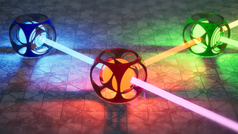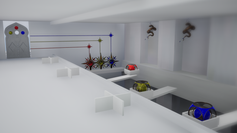Astral Hues

Type
First Person Puzzle
Role
Game Designer / Programmer / UI
Year
2022 - 2023
Contributions made using:




What is it about?
In this First Person puzzle game, the player must traverse through a mysterious temple in order to complete their pilgrimage.
In their path, puzzles they will have to resolve by mixing lights and colors using an unique RBG light beam system!
By placing and powering cubes, the player can clear up the path and continue forward!
As the Game Designer on the project, I conceptualized all the gameplay mechanics and coded them with UE Blueprints.
This project is still in production!

Trailer
Game Design

Gameplay Concepts
-
Conceptualize a core mechanic that can be extrapolated into multiple puzzles.
-
Quickly iterate on it by prototyping with UE Blueprints.
-
Identify through testing and early feedback what works and what doesn't.
-
Make sure the gameplay elements are technically possible.
-
Create tools for the Level Designers to quickly conceptualize, build and playtest their levels.
-
Program every systems in UE Blueprints
Cube and Light
-
For a Cube to be lit, it needs to be powered by a Generator, a Generator can only power one Cube at a time.
-
A Light Beam emitted by a powered Cube can power other Cubes that it passes through.
-
The Cube will emit a Light Beam only of its color.
-
If said Light Beam goes through another Cube, it will exit tinted by that color according to an additive RGB model.
Doors and Receivers
-
Each level requires Doors to be opened to progress. To do so, the player much light the Receivers connected to them with the appropriate color.
-
Some Doors require more than one color to open.
-
It is up to the player to figure out how to get the Light Beams to the matching Receivers.


Core Mechanic





Light Beams and the Color System
-
When going through Cubes, Light Beams are tinted according to the additive RGB color model (Red + Blue gives Magenta, Magenta + Green gives White, etc...)
-
I however simplified the system to only 7 colors for gameplay reasons (Avoids the need to take into account milions of hues)
Mirrors and Reflections
-
Functions exactly like one would expect; renders the scene exactly as it is through the use of planar reflections. Makes aiming a beam through it much easier.
-
Light Beams are programmed to be properly reflected as well and keep their logic intact.
-
As it is a very expensive rendering method, the mirrors are thoroughly optimized and so are the levels they exist in; reducing draw calls as much as possible.
Wind and movement
-
A secondary mechanic, the power of Wind let's the player activate various mecanisms, adding movement to an otherwise fairly static game.
-
Functions like an "on/off" toggle, with charges that can be placed or taken at will, adding a layer of complexity.
Gameplay Systems



UI and Interactions
-
To assist in the player learning the game, icons appears contextually to indicate which actions can be done.
-
Each icon is marked with the correct input to perform.
-
To not clutter the screen, each click is placed on the matching side of the center point. (left or right depending on left or right click.
-
To assist with color legibility, the center point changes color depending on what color the object the player is looking at is.

User Interface

Gallery


























